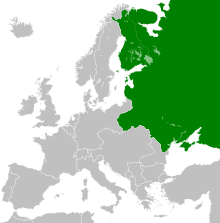
Back Урыстәылатәи аимпериа Abkhazian Russiese Ryk Afrikaans Russisches Kaiserreich ALS የሩሲያ ግዛት Amharic Imperio Ruso AN रूसी साम्राज्य ANP الإمبراطورية الروسية Arabic الامبراطوريه الروسيه ARZ Imperiu Rusu AST Россиялъул империя AV
Russian Empire Россійская Имперія Российская Империя Rossiyskaya Imperiya | |||||||||||
|---|---|---|---|---|---|---|---|---|---|---|---|
| 1721–1917 | |||||||||||
| Motto: "Съ нами Богъ!" S' nami Bog! ("God is with us!") | |||||||||||
| Anthem: "Боже, Царя храни!" Bozhe Tsarya khrani! (1833–1917) ("God Save the Tsar!") Other used anthems:
| |||||||||||
| Capital | Saint Petersburg[b] (1721–1728; 1730–1917) Moscow (1728–1730)[2] | ||||||||||
| Largest city | Saint Petersburg | ||||||||||
| Official languages | Russian • French (widely used among the upper classes until the 19th century)[3] | ||||||||||
| Recognised languages | Polish, German (in Baltic provinces), Finnish, Swedish, Chinese (in Dalian) | ||||||||||
| Religion (1897) |
| ||||||||||
| Demonym(s) | Russian | ||||||||||
| Government | Unitary absolute monarchy (1721–1906) Unitary parliamentary semi-constitutional monarchy[5] (1906–1917) | ||||||||||
| Emperor | |||||||||||
• 1721–1725 (first) | Peter I | ||||||||||
• 1894–1917 (last) | Nicholas II | ||||||||||
• 1810–1812 (first) | Nikolai Rumyantsev[c] | ||||||||||
• 1917 (last) | Nikolai Golitsyn[d] | ||||||||||
| Legislature | Governing Senate[6] | ||||||||||
| State Council (1810–1917) | |||||||||||
| State Duma (1905–1917) | |||||||||||
| History | |||||||||||
| 10 September 1721 | |||||||||||
• Proclaimed | 2 November 1721 | ||||||||||
| 4 February 1722 | |||||||||||
| 26 December 1825 | |||||||||||
| 3 March 1861 | |||||||||||
| 18 October 1867 | |||||||||||
| Jan 1905 – Jul 1907 | |||||||||||
| 30 October 1905 | |||||||||||
• Constitution adopted | 6 May 1906 | ||||||||||
| 8–16 March 1917 | |||||||||||
• Proclamation of the Republic | 14 September 1917 | ||||||||||
| Area | |||||||||||
| 1866[7][8] | 22,800,000 km2 (8,800,000 sq mi) | ||||||||||
| Population | |||||||||||
• 1897 | 125,640,021 | ||||||||||
| Currency | Russian ruble | ||||||||||
| |||||||||||

The Russian Empire, also known as Tsarist Russia, Tsarist Empire or Imperial Russia, and sometimes simply as Russia,[e][f] was a country in Europe and Asia from November 1721 until its dissolution in March 1917. When the Russian Empire collapsed, it became the Russian Soviet Federative Socialist Republic (Russian SFSR), as part of the Soviet Union.
By the late 19th century, it covered about 22,800,000 km2 (8,800,000 sq mi), making it the third-largest empire in history.
Cite error: There are <ref group=lower-alpha> tags or {{efn}} templates on this page, but the references will not show without a {{reflist|group=lower-alpha}} template or {{notelist}} template (see the help page).
- ↑ "St. Petersburg through the Ages". St. Petersburg International Economic Forum. Archived from the original on 6 August 2022. Retrieved 6 August 2022.
- ↑ "18th Century in the Russian History", Rusmania. Archived 19 March 2022 at the Wayback Machine.
- ↑ The French Language in Russia (PDF). Amsterdam University Press. Retrieved April 19, 2024.
- ↑ J. Coleman, Heather (2014). Orthodox Christianity in Imperial Russia: A Source Book on Lived Religion. Indiana University Press. p. 4. ISBN 9780253013187.
After all, Orthodoxy was both the majority faith in the Russian Empire – approximately 70 percent subscribed to this faith in the 1897 census–and the state religion.
- ↑ Williams, Beryl (1 December 1994). "The concept of the first Duma: Russia 1905–1906". Parliaments, Estates and Representation. 14 (2): 149–158. doi:10.1080/02606755.1994.9525857.
- ↑ "The Sovereign Emperor exercises legislative power in conjunction with the State Council and State Duma". Fundamental Laws, "Chapter One On the Essence of Supreme Sovereign Power Article 7." Archived 8 June 2019 at the Wayback Machine
- ↑ Rein Taagepera (September 1997). "Expansion and Contraction Patterns of Large Polities: Context for Russia". International Studies Quarterly. 41 (3): 475–504. doi:10.1111/0020-8833.00053. JSTOR 2600793. Archived from the original on 19 November 2018. Retrieved 28 June 2019.
- ↑ Turchin, Peter; Adams, Jonathan M.; Hall, Thomas D. (December 2006). "East-West Orientation of Historical Empires". Journal of World-Systems Research. 12 (2): 223. ISSN 1076-156X. Archived from the original on 17 September 2016. Retrieved 11 September 2016.





